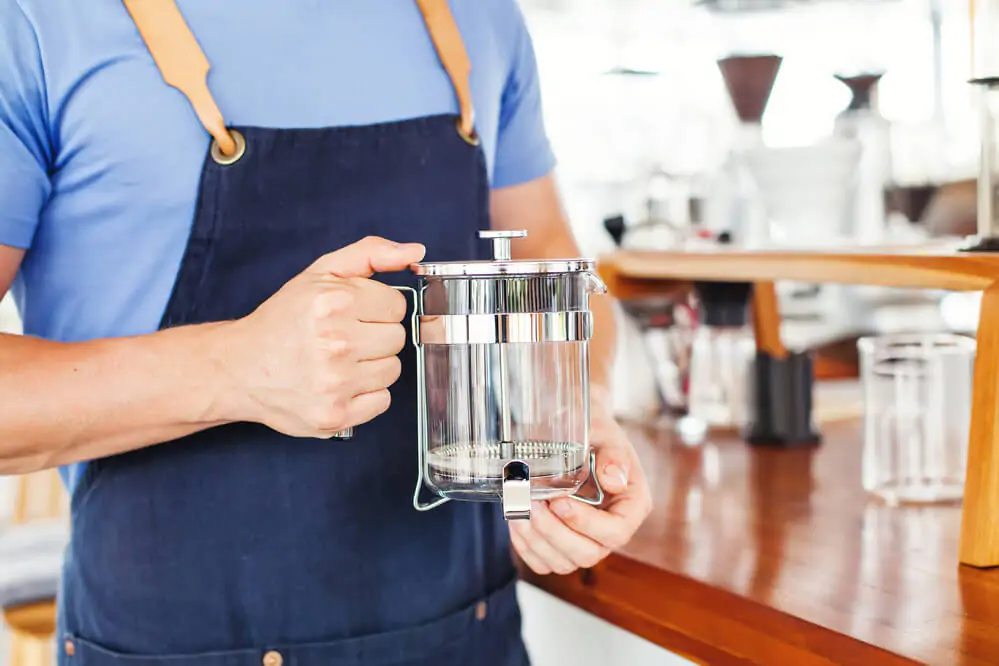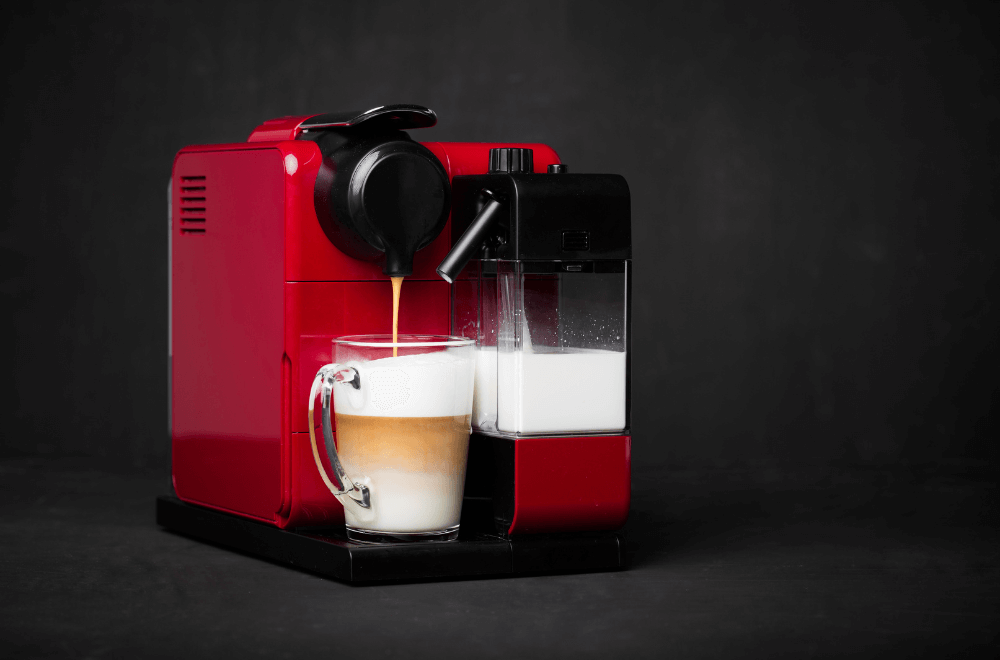If you are wondering whether or not can you put milk in a coffee maker, then this article will advise you on what is best practice.

When people ask if they can put milk into their coffee maker, they are usually referring to adding milk into their French Press. That is because, with Moka pots, espresso machines, and drip coffee makers, it’s obvious what you can and can’t do.
These machines are designed to brew coffee; all you add to them is coffee beans and water. Of course, for espresso drinks, you can add steamed milk using a milk frother after it is made to create a latte, a cappuccino, or whatever your favorite cup of coffee is. With a French Press, it is not so obvious because there is space for milk if you want to add it.
However, as this article explains, that probably isn’t the best idea.
Can You Add Milk Directly To a French Press?
A French Press’s beauty lies in how water extracts flavor from the grounds. Also, you need enough water to ensure the grounds sink to the bottom of the pot due to its density. You must let the coffee grounds settle down and sit in water for a few minutes (preferably 3-4 minutes).
And put simply, adding milk directly to the French Press will stir up the content and spoil the effect.
The milk fat can also clog the filter, and there are higher chances that your brew will have sludge if you add milk directly to the press. Sludge is the finer particles of the coffee grounds that easily make their way into the cup when milk is added.
Adding milk will also significantly reduce the temperature of the brew. And you won’t be able to tell if the extraction process is over before pouring out the drink.
Heat has a vital role in the extraction process, and to get the best results; you must aim for a temperature of 200. Milk, however, starts curdling at 180, which comes in the way of achieving a complete extraction.
Another downside is that when you mix things up, you are stuck with that ratio. You cannot make your coffee stronger if you want. If you have to add milk, I suggest pouring the coffee into another vessel and then adding milk to it.
When Can You Add Milk Directly To A French Press?
If you are determined to add milk to your coffee maker, you must wait until the preliminary brewing time is over, which usually takes 3 to 4 minutes. Adding milk before the extraction is complete may stop the process or slow it down, resulting in a weak coffee.
Ideally, you should press the filter down, pour coffee into a mug, and then add whatever you want per your preference. As for the strainer, the milk fat will clog it, so make sure you clean the filter thoroughly for the next time you brew ground coffee.
The filter used in a French press is basically a stainless steel mesh, and milk fat can quickly build up on the surface. If you do not clean the filter properly, milk residue could clog the pores and turn sour. This will affect the flavor and taste of your next brew and give it a bitter taste.
As mentioned above, a French Press is designed to give you the pure delight of raw coffee. Adding milk and sugar will weaken the flavor and make it difficult to clean and maintain the brewing device.
How To Properly Clean Your French Press?

Whether you add milk or not, you will need to clean your French press after each use to ensure that it delivers an excellent coffee brewing experience the next time. If you have used milk, the cleaning may take longer and must be done carefully to ensure no milk fat residue is left behind.
Below I have listed the steps to clean a French press after each use.
Step 1
Empty the carafe by digging out the coffee grounds using your hand or a spatula. Do not use any metal spoon or sharp object as this may break the glass. Dump the grounds into the garbage or recycle them, because if they go into the sink, they may clog the pipe over time.
Step 2
Disassemble the French press into its different components, such as the lid, filter screens, coffee plunger, disks, and water reservoir. Gently remove the grounds trapped between the disks and rinse them in clean tap water.
Step 3
Add some mild detergent or liquid dish soap to water and put the solution into the carafe. Now move the plunger up and down a few times to make bubbles in the water. Drain the liquid and rinse again with clean water.
Step 4
Now take a sponge or brush with soft bristles and gently scrub the inner side of the carafe and all the French press parts, including the filter screen and plunger.
Step 5
Once all the parts are scrubbed clean, rinse again with water until all the soapy solution runs out.
Barista tip
Some coffee aficionados are so obsessed with their brewing device that they do not wash them with soap. They prefer baking soda to ensure that no outside flavor comes in the way of coffee.
If you get hard water in your area, you can use a mix of water and vinegar to thoroughly clean the carafe and the disassembled components.
After all the pieces are cleaned well, let them air dry by putting out the pieces separately on a shelf. Alternatively, you can also towel dry or use a clean, soft cloth for drying. After the parts are dry, reassemble them together so that you can enjoy delicious coffee again next time.
Alternatives To Adding Milk To Your Coffee Machine
As we stated, adding milk to your coffee machine can result in a weaker coffee taste, and it can affect your coffee brewers in the future. To use milk in a Moka pot or espresso maker will result in something even worse; burnt milk and the potential of a broken machine.

You shouldn’t ever substitute milk for water with coffee machines either. There has been noted incidents of broken heating elements in Nespresso machines because of this.
However, let’s get to the crux of the issue. If you are considering adding milk to your brew, it is probably because you don’t like the bitter taste of strong coffee. If that is the case, then you simply go for coffee with a creamer or syrups to lessen the strong taste.
A macchiato, cappuccino, or latte are great options here, however any drink that uses milk foam (added to the coffee cup after the hot coffee after itis brewed and poured) is a good option.
For these types of coffee drinks, you use water to brew the coffee. The hot water helps brew the coffee, with a different amount of milk boiled and frotted and added to create the milk-based drink.
If unsure, ask the expert at your local coffee shop and they should be able to direct you to a drink that suits your taste buds. Or you can simply experiment at your local Starbucks until you find a delicious tasting coffee that suits you.
Worst case scenario is that you simply don’t like the taste of regular coffee and you have to move over to a drink that is milk-based, like hot chocolate. The good news is that you can always add an espresso to that hot milk treat.
